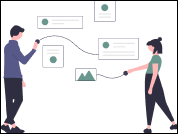Hire the Best Digital Communication Strategy Talent for Your Project
What is a digital communication strategy? Your digital communication strategy should build audience engagement around new products and services by using innovative technology to communicate and delight your target audience and ultimately drive leads and sales.
Our Talent has worked with
How it Works
Post your project details
Tell us what you need, when you need it, and the type of skill set you are looking to hire. List your project on our platform for talent to see.

Choose from our top Talent
Browse from hundreds of vetted experts, and invite talent to pitch on the project. Browse through their skills sets, qualifications, and utilize the chat box for real time communication.

Collaboration made easy
Once the client identifies which profile(s) they wish to work with, the client is able to invite the talent to the project, with both client and talent agreeing on deliverables, price and timeline of the engagement.

Receive proposals and hire talent
Congratulations! You and your freelancer are ready to get to work. Payment and contract integration all happen on the platform automatically for you.

Your digital communication strategy is the main way to effectively convey your brand’s message to your consumers. A digital communication strategy is effective in aligning measurable communications objectives, identifying your target audience, building your brand, increasing channel engagement, among other benefits. Use your company’s goals, target segments, marketing tactics, and KPIs to optimize your digital communication strategy.
How to create a strong digital communication strategy:
A holistic communication strategy incorporates a mix of paid, earned, and owned media to leverage your brand. Knowing how to navigate each set of media and integrate them seamlessly in your channels is important in building a strong digital communication strategy.
Paid media involves purchasing media placements for your messages. This includes paid content promotion, paid influencers, and promoted social media content, or advertising on third-party sites. Earned media is when your consumers and the public share and engage with your content. This includes coverage, shares, reports, and reviews on third-party sites, publications, and external social media channels. Share of voice is a good measure of your earned media, or the percentage of a company’s earned media coverage versus that of competitors. Owned media measures how well your brand leverages the online and offline places that you own as successful media platforms. Examples of owned media are your website, your social media platforms, YouTube channel, blog, email list, company buildings, among others.
Influencer marketing: Influencer marketing can be used to expand your credibility and reach, as well as creating strong paid partnerships with media masters. Working with bloggers, YouTubers, and social media figures to boost brand awareness and generate leads is a great way to expand your digital communication strategy. Start by identifying respected industry voices with great key-word search and a strong following within your target audience. Next, evaluate how this influencer will elevate your brand’s presence and inspire consumer action. Then, work with the influencer to create a mutually beneficial relationship to find a synergistic approach.
SEO Optimization: SEO, or search engine optimization, is crucial in gathering traffic to your site. SEO helps companies to understand how consumers are searching for your brand online. Good digital communication strategies know how to implement SEO to increase web traffic and boost visibility and rankings.
Content marketing: Content marketing is a form of marketing focused on creating, publishing, and distributing content for a targeted audience online. Content marketing is important in reaching your target audience and showing them the quality content they are interested in. Implementing content marketing in your digital communication strategy can help build a strong content map for the entire process of the consumer journey, from brand awareness to point of purchase to post-purchase satisfaction, can help to gather trust between your company and your consumers.
Amplification: Amplification is important in the stage of distributing your content and making sure it’s reaching the right people. Amplifying your content throughout a mix of paid, owned, and earned media channels boosts content visibility and engages target consumers throughout all processes of the consumer decision journey. Incorporating amplification into your digital communication strategy can help with generating a greater ROI and understanding of what type of content works best on each channel.
Data-Driven Metrics: Being able to measure your success in digital communications is important in improving your strategy and appealing to your target audience. Data-driven metrics are important when measuring engagement, identifying strengths and weaknesses and conducting SWOT analyses, and improving your strategy. A great tool to use is Google Analytics, which provides website analytics to measure traffic, advertising ROI, consumer behavior, and goal conversions.














